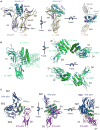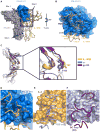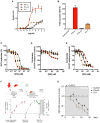The IFN-λ-IFN-λR1-IL-10Rβ Complex Reveals Structural Features Underlying Type III IFN Functional Plasticity
- PMID: 28329704
- PMCID: PMC5510750
- DOI: 10.1016/j.immuni.2017.02.017
The IFN-λ-IFN-λR1-IL-10Rβ Complex Reveals Structural Features Underlying Type III IFN Functional Plasticity
Abstract
Type III interferons (IFN-λs) signal through a heterodimeric receptor complex composed of the IFN-λR1 subunit, specific for IFN-λs, and interleukin-10Rβ (IL-10Rβ), which is shared by multiple cytokines in the IL-10 superfamily. Low affinity of IL-10Rβ for cytokines has impeded efforts aimed at crystallizing cytokine-receptor complexes. We used yeast surface display to engineer a higher-affinity IFN-λ variant, H11, which enabled crystallization of the ternary complex. The structure revealed that IL-10Rβ uses a network of tyrosine residues as hydrophobic anchor points to engage IL-10 family cytokines that present complementary hydrophobic binding patches, explaining its role as both a cross-reactive but cytokine-specific receptor. H11 elicited increased anti-proliferative and antiviral activities in vitro and in vivo. In contrast, engineered higher-affinity type I IFNs did not increase antiviral potency over wild-type type I IFNs. Our findings provide insight into cytokine recognition by the IL-10R family and highlight the plasticity of type III interferon signaling and its therapeutic potential.
Copyright © 2017 Elsevier Inc. All rights reserved.
Figures






Similar articles
-
Tyrosine kinase 2 is not limiting human antiviral type III interferon responses.Eur J Immunol. 2016 Nov;46(11):2639-2649. doi: 10.1002/eji.201646519. Epub 2016 Oct 5. Eur J Immunol. 2016. PMID: 27615517
-
Characterization of Monoclonal Antibodies to Measure Cell Surface Protein Levels of Human Interferon-Lambda Receptor 1.J Interferon Cytokine Res. 2023 Sep;43(9):403-413. doi: 10.1089/jir.2023.0040. Epub 2023 Jul 27. J Interferon Cytokine Res. 2023. PMID: 37499093
-
Differential expression of interferon-lambda receptor 1 splice variants determines the magnitude of the antiviral response induced by interferon-lambda 3 in human immune cells.PLoS Pathog. 2020 Apr 30;16(4):e1008515. doi: 10.1371/journal.ppat.1008515. eCollection 2020 Apr. PLoS Pathog. 2020. PMID: 32353085 Free PMC article.
-
Novel type III interferons produce anti-tumor effects through multiple functions.Front Biosci (Landmark Ed). 2013 Jun 1;18(3):909-18. doi: 10.2741/4152. Front Biosci (Landmark Ed). 2013. PMID: 23747856 Review.
-
IFN-λs.Curr Opin Immunol. 2011 Oct;23(5):583-90. doi: 10.1016/j.coi.2011.07.007. Epub 2011 Aug 15. Curr Opin Immunol. 2011. PMID: 21840693 Free PMC article. Review.
Cited by
-
The Role of Structure in the Biology of Interferon Signaling.Front Immunol. 2020 Nov 12;11:606489. doi: 10.3389/fimmu.2020.606489. eCollection 2020. Front Immunol. 2020. PMID: 33281831 Free PMC article. Review.
-
Molecular analysis of the type III interferon complex and its applications in protein engineering.Biophys J. 2023 Nov 7;122(21):4254-4263. doi: 10.1016/j.bpj.2023.09.021. Epub 2023 Oct 4. Biophys J. 2023. PMID: 37794680 Free PMC article.
-
Interferon Lambda: The Next Frontier in Antiviral Therapy?Pharmaceuticals (Basel). 2025 May 24;18(6):785. doi: 10.3390/ph18060785. Pharmaceuticals (Basel). 2025. PMID: 40573183 Free PMC article. Review.
-
A stimulus-contingent positive feedback loop enables IFN-β dose-dependent activation of pro-inflammatory genes.Mol Syst Biol. 2023 May 9;19(5):e11294. doi: 10.15252/msb.202211294. Epub 2023 Mar 17. Mol Syst Biol. 2023. PMID: 36929731 Free PMC article.
-
Human Cervical Epithelial Cells Release Antiviral Factors and Inhibit HIV Replication in Macrophages.J Innate Immun. 2019;11(1):29-40. doi: 10.1159/000490586. Epub 2018 Jul 20. J Innate Immun. 2019. PMID: 30032138 Free PMC article.
References
-
- Andrus L, Marukian S, Jones CT, Catanese MT, Sheahan TP, Schoggins JW, Barry WT, Dustin LB, Trehan K, Ploss A, et al. Expression of paramyxovirus V proteins promotes replication and spread of hepatitis C virus in cultures of primary human fetal liver cells. Hepatology. 2011;54:1901–1912. - PMC - PubMed
Publication types
MeSH terms
Substances
Grants and funding
LinkOut - more resources
Full Text Sources
Other Literature Sources

